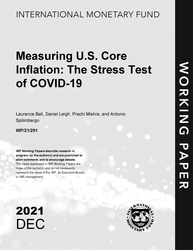
Measuring U.S. Core Inflation: The Stress Test of COVID-19
Measuring U.S. Core Inflation: The Stress Test of COVID-19
READ MORE...
Volume/Issue:
Volume 2021
Issue 291
Publication date: December 2021
ISBN: 9781616357580
$5.00
Add to Cart by clicking price of the language and format you'd like to purchase
Available Languages and Formats
| English |
Prices in red indicate formats that are not yet available but are forthcoming.
Topics covered in this book
This title contains information about the following subjects.
Click on a subject if you would like to see other titles with the same subjects.
Inflation , Labor , Economics- Macroeconomics , Economics / General , Inflation , business fluctuations , central banks , , sticky-price inflation rate , XFE inflation , price change , changes in industry , inflation measure , Inflation , Consumer price indexes , COVID-19 , Deflation , Unemployment
Summary
Large price changes in industries affected by the COVID-19 pandemic have caused erratic fluctuations in the U.S. headline inflation rate. This paper compares alternative approaches to filtering out the transitory effects of these industry price changes and measuring the underlying or core level of inflation over 2020-2021. The Federal Reserve’s preferred measure of core, the inflation rate excluding food and energy prices (XFE), has performed poorly: over most of 2020-21, it is almost as volatile as headline inflation. Measures of core that exclude a fixed set of additional industries, such as the Atlanta Fed’s sticky-price inflation rate, have been less volatile, but the least volatile have been measures that filter out large price changes in any industry, such as the Cleveland Fed’s median inflation rate and the Dallas Fed’s trimmed mean inflation rate. These core measures have followed smooth paths, drifting down when the economy was weak in 2020 and then rising as the economy has rebounded. Overall, we find that the case for the Federal Reserve to move away from the traditional XFE measure of core has strengthened during 2020-21.
Copyright © 2010 - 2025
Powered by:
AIDC



